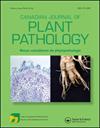甜樱桃(Prunus avium L.)的微生物群落及其与樱桃滑皮浸渍障碍关系的评价
IF 1.5
4区 农林科学
Q3 PLANT SCIENCES
引用次数: 1
摘要
摘要甜樱桃(Prunus avium L.)的一种相对较新的情况,即樱桃滑皮浸渍障碍(cherry SSMD),可能与酵母物种有关,需要对商业樱桃树果实和花朵中的微生物群落进行详细研究。樱桃SSMD主要影响晚熟甜樱桃的果实质量,并可能导致与一种或多种不同但通常为非致病性酵母有关的症状发展。这些症状可能是水果正常微生物群发生显著变化的结果,进而可能受到与不同收获日期相关的树木果实酚学和/或环境因素的影响。因此,本研究的主要目的是进行实地调查,以调查樱花和果实上的微生物物种组成。从2013年和2014年生长季节进行的调查中获得的结果表明,尽管真菌数量仍然很低,但在整个生长季节,正在发育的果实表面的酵母和细菌数量继续增加。物种组成也被观察到在不同年份和整个生长季节是可变的。然而,尽管在收获前细菌和酵母的微生物种群普遍增加,但没有观察到任何特定的模式表明微生物群落或单个物种与樱桃SSMD之间存在联系。本文章由计算机程序翻译,如有差异,请以英文原文为准。
Microbial communities of sweet cherry (Prunus avium L.) and assessment of their association with cherry slip-skin-maceration disorder
Abstract A relatively new condition of sweet cherry (Prunus avium L.), cherry slip-skin-maceration disorder (cherry-SSMD), presumably associated with yeast species, required a detailed study looking at the microbial communities inhabiting the fruit and blossoms of commercial cherry trees. Cherry-SSMD affects the fruit quality of mainly late harvest sweet cherries and may lead to symptom development that is associated with one or more different, but typically non-pathogenic yeast species. These symptoms may be the result of significant shifts within the fruit’s normal microbiota, and may in turn be influenced by tree fruit phenology and/or environmental factors relating to variable harvest dates. Therefore, the main objective of this study was to conduct field surveys to investigate the microbial species composition on cherry blossoms and fruit. Results obtained from surveys conducted during the 2013 and 2014 growing seasons indicated that while fungal populations remained low, numbers of yeasts and bacteria continued to increase on the surface of developing fruit throughout the growing season. Species composition was also observed to be variable between years and throughout the growing seasons. However, despite general increases in microbial populations of bacteria and yeasts leading up to harvest, no specific pattern was observed to suggest a pathogenic profile that would link either microbial communities, or individual species to cherry-SSMD.
求助全文
通过发布文献求助,成功后即可免费获取论文全文。
去求助
来源期刊
CiteScore
4.50
自引率
5.00%
发文量
56
审稿时长
6-12 weeks
期刊介绍:
Canadian Journal of Plant Pathology is an international journal which publishes the results of scientific research and other information relevant to the discipline of plant pathology as review papers, research articles, notes and disease reports. Papers may be submitted in English or French and are subject to peer review. Research articles and notes include original research that contributes to the science of plant pathology or to the practice of plant pathology, including the diagnosis, estimation, prevention, and control of plant diseases. Notes are generally shorter in length and include more concise research results. Disease reports are brief, previously unpublished accounts of diseases occurring on a new host or geographic region. Review papers include mini-reviews, descriptions of emerging technologies, and full reviews on a topic of interest to readers, including symposium papers. These papers will be highlighted in each issue of the journal and require prior discussion with the Editor-in-Chief prior to submission.

 求助内容:
求助内容: 应助结果提醒方式:
应助结果提醒方式:


